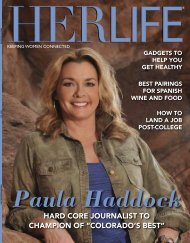Central Valley's Fitness Visionary - HER LIFE Magazine
Central Valley's Fitness Visionary - HER LIFE Magazine
Central Valley's Fitness Visionary - HER LIFE Magazine
You also want an ePaper? Increase the reach of your titles
YUMPU automatically turns print PDFs into web optimized ePapers that Google loves.
herlife | culinaryFacts onFats andCookingOilsby natasha loganHow many of you remember being in your grandmother’skitchen, watching her dip into her trusty can of Criscoor seasoning her dishes from a jar of bacon drippings?Grandma knew that our bodies required fat to function.In addition to carbohydrates and protein, fatscomplete the triad of major nutrients our bodies need. Our brains arecomprised mostly of fat which makes up its cell membranes. Fats andoils stabilize blood sugar levels and provide raw materials for makinghormones, so we should incorporate fats into our daily diet. Fats andoils work the same in our body, but fats are solid at room temperaturewhile oils are liquid.Triglycerides are the chemical form of fats in food and our body.Think of fats as a building and triglycerides as the bricks that give itshape. Every “brick” contains three fatty acids: saturated, monounsaturatedand polyunsaturated (the “tri”), and one glycerol molecule(the “glyceride”). Each type of fat has a combination of fatty acidsthat comprise its “bricks.” For instance, olive oils have more monounsaturatedfatty acids than saturated or polyunsaturated fatty acids,making them a monounsaturated fat.Saturated fats are the most chemically stable, which allow thema longer shelf life and the ability to withstand high cooking temperatures.Found primarily in animal fats and tropical oils, some examplesof animal fats are butter, cream and tallow. However, two of the mosthighly saturated fats–coconut oil and palm kernel oil–come from vegetablesources. Interestingly, the fatty acid composition of animal fatcan vary depending on the animal’s diet.When choosing a fat for cooking, monounsaturated fats areheart-healthy because they maintain “good” HDL cholesterol levelswhile lowering “bad” LDL cholesterol levels. They are best used forlight cooking, or raw in salad dressings and sauces. Oils that arepredominantly monounsaturated include avocado, peanut, sesame,lard and duck fat.Polyunsaturated fatty acids are more likely to become rancid thansaturated and monounsaturated fatty acids, especially after exposure tooxygen, light or heat. Oils that are predominately polyunsaturated includewalnut, grapeseed, soy, corn and fish oils. They are best used in their rawform, should never be kept beyond their expiration date, should be usedat low temperatures and kept refrigerated in dark bottles.The worst kind of fats are trans fatty acids, which are chemicallyaltered, man-made fats found in partially hydrogenated oils. The hydrogenationprocess injects hydrogen into vegetable fats under highheat and pressure, resulting in the saturation of what was previouslyan unsaturated fat, and creating a chemical configuration not foundin nature. This is done to extend the shelf life of vegetable oils. Transfats lower HDL cholesterol and raise LDL cholesterol levels, increasingthe risk of coronary heart disease.Determine if the dish you’re preparing calls for unrefined or refinedoil. Unrefined oils are salad oils, and are best used in marinades,sauces and salad dressings. Since they should not be used at hightemperatures, they are best for light sautéing and low heat baking.Unrefined oils are processed by cold-pressed and expeller-pressedmethods which provide the true bouquet of whatever plant was theoil’s original home. Because of this, unrefined oils can dominate adish or baked good, and are often used as flavoring agents.Refined oils are extracted from clean oilseed or oil cakes bysolvent extraction for further refining to produce clear oil free from34 <strong>HER</strong><strong>LIFE</strong>MAGAZINE.COM
















